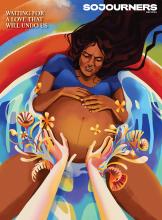A LITTLE OVER a year ago, members of Ann Arbor’s Zion Lutheran Church in Michigan stood on an L-shaped plot bordering their church garden. Those 800 square feet of ordinary lawn were on the cusp of transformation, about to become the source of Zion’s own Communion bread.
While Christians traditionally think of Communion as transforming partakers during the church service, project leader Betsy King-McDonald wanted to explore the life-giving properties of the Eucharist at an earlier stage — starting in the soil.
“How can we foster life in all the choices we make to the table?” she asked. This question led King-McDonald, a doctoral student at Western Theological Seminary, to partner with Zion Lutheran in growing heirloom wheat for their Communion bread.
In the slanting October light, members rototilled the church lawn. Youth lugged wheelbarrows of wood chips from the parking lot. Then Joet Reoma, a local master gardener and board member of Project Grow, a local nonprofit that facilitates community gardens, directed participants in a complex ritual that resembled making a dirt lasagna. The “lasagna” was not for humans, but for the microbial life in the recently turned soil.
In a trademark black cap with tag still attached, his name scrawled on the tag in bold black marker, Reoma called out basic permaculture steps: First, spread fresh wood chips, high in nitrogen but slow to decompose. Next, add a layer of vermicompost — worms with their eggs and castings, ready to break down the organic matter. Sprinkle cornmeal on top, energizing the worms and kick-starting mycelial growth in the wood chips. Finally, two more layers; one of decomposed wood chips and one of compost. Now, the soil community was ready to receive the wheat seeds.
This elaborate process of feeding the soil that would nurture the church’s Communion wheat expressed a deep eucharistic truth — the process and the produce hold the power of life.
Rarely do churches interrogate how liturgical elements support life all along the way — from soil to markets to table. As King-McDonald found, tending to the process clears a path for deeper place-based Christian discipleship.
After poking neat rows of holes in the living soil, Zion Lutheran’s team dropped wheat kernels into the darkness, covered them, and spread a layer of straw over it all.
Read the Full Article

